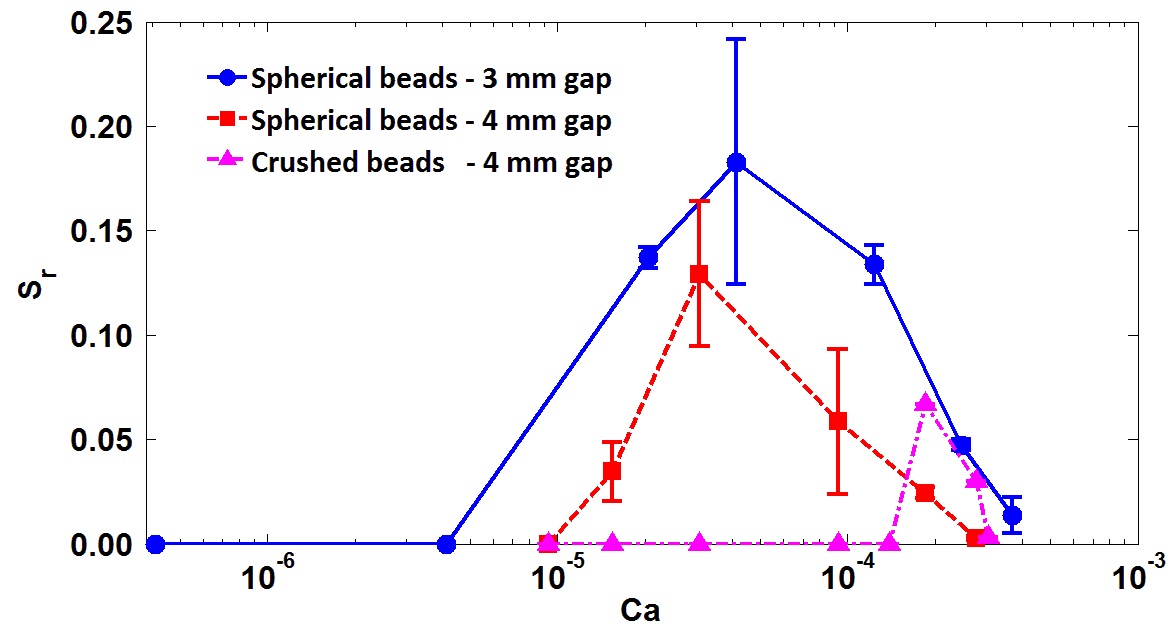58th Annual Report on Research 2013 Under Sponsorship of the ACS Petroleum Research Fund
Reports: DNI652054-DNI6: Fundamental studies of the morphology and dynamics of the phase entrapment in immiscible two-phase flow through porous media
Nima Shokri, PhD, University of Manchester
During the process of immiscible displacement of a receding fluid by an invading fluid in porous media one or more pores may be bypassed by the invading fluid as it advances through the medium. This process creates disconnected fluid clusters which are left behind, trapped in the porous structure. Enhanced knowledge of the parameters affecting the morphology and distribution of the trapped fluid in porous media is required for exploitation in various applications such as soil remediation or the enhanced oil recovery.
In the first phase of this project, we investigated the effects of flooding history on the amount of the trapped fluid at different capillary numbers (defined as the ratio of viscous to capillary forces) ranging from 10-6 to 10-3. In total 43 rounds of imbibition experiments through spherical and crushed glass beads with particle sizes ranging from 0.5 to 1 mm packed in a quasi-two-dimensional transparent Hele-Shaw cell (100mm x 100mm x 4mm) were conducted. Dyed water as wetting and displacing fluid was injected into the glass cell initially saturated with the nonwetting phase which was either Soltrol 220 or PCE with the dynamics viscosity of 4.12 and 0.89 cP respectively. The dynamics and patterns of fluid phase distributions were visualized using a high resolution CCD camera connected to a computer. The image resolution was 2560x2048 pixels resulting in a spatial resolution of 0.04 mm per pixel. The codes required to segment the digitalized images to black and white images were developed to quantify the dynamics of immiscible two-phase fluid flow.
Figure 1 illustrates a typical example of raw images with the corresponding black and white images.
Figure 1. (a,b,c) The raw images recorded during dyed water injection (dark gray) in the quasi-2D Hele-Shaw cell packed with glass beads saturated with oil (light gray). The porous medium was placed horizontally and the injection is from right to left. The numbers indicate the elapsed time from the beginning of the experiment. (d,e,f) the corresponding black and white images with black and white indicating the water saturated and oil saturated regions, respectively.
The injection of the displacing fluid was continued until steady state was reached and no change in the phase distribution was observed. At that point, the flow rate of the invading fluid was increased and flooding was continued until reaching a new steady-state condition. This procedure was repeated till reaching the maximum designed capillary number. Our findings have two major contributions:
(a) in a fairly homogenous quasi-two dimensional model, not only the size and shape of the trapped oil clusters depend on the history of flooding but also the residual oil saturation strongly depends on the history of flooding rather than the ultimate flow rate. For example, remarkably less oil entrapment was observed when the injection rate started from a low capillary number gradually increased to the ultimate (high) capillary number compared to the case when the injection was performed with the ultimate (high) capillary number as illustrated in Figure 2.
Figure 2. Quantitative analysis of the effect of the history of flooding on the residual saturation of oil. Sr, Cai, and Caf refers to the residual oil saturation, initial and final capillary number, respectively.
(b) a non-monotonic relation between the capillary number and residual saturation was observed which has been rarely reported in the literature as in most cases monotonic capillary desaturation curves are presented. Figure 3 illustrates the results obtained.
Figure3: Capillary desaturation curve showing the residual saturation (Sr) versus capillary number (Ca). Two Hele-Shaw cells were used in these experiments with the thickness of 3 and 4 mm as indicated in the legend. Also, K refers to the viscosity ratio between the displacing and displaced fluid.
This observation may be due to homogeneous distribution of pore sizes over the model causing a fairly homogeneous distribution of capillary forces at the invading front. Consequently, as flow rate increases, instability at the interface due to inverse viscosity ratio may increase the chance of trapping. However, after a certain capillary number, further increase of the injection rate will create enough drag force to mobilize the trapped zones resulting in reduction of the residual oil saturation. This non-monotonic observation is consistent over the examined viscosity ratio of 4.12 and 0.88 in both spherical and crushed glass beads. This analysis will be soon submitted to a peer-reviewed journal with a high impact factor for publication.
This project had a great influence on the PI's career as it opened a new line of research for him. The results obtained are novel and can be potentially very important not only in issues related to the enhanced oil recovery but also the fundamental understanding of two-phase fluid flow in porous media. The PI is planning to hire a PhD student to continue working on this topic over the next few years. The experiments were conducted by Dr. Homa Khosravian who was hired on this project as a post-doctoral researcher.
In addition to the experiments reported above, a part of this award was used to investigate the dynamics of solute distribution in porous media in which two students (one undergraduate and one PhD student) were involved. The experiments were conducted using synchrotron x-ray micro-tomography at the GeoSoilEnviroCARS(GSECARS) BM-13BMD beamline at the Advanced Photon Source, Argonne National Laboratory, IL. The result of that study has been already published in Physics of Fluids which was the first study illustrating the dynamics of solute distribution in porous media at pore scale with a high spatial and temporal resolution.
Copyright © 2014 American Chemical Society














